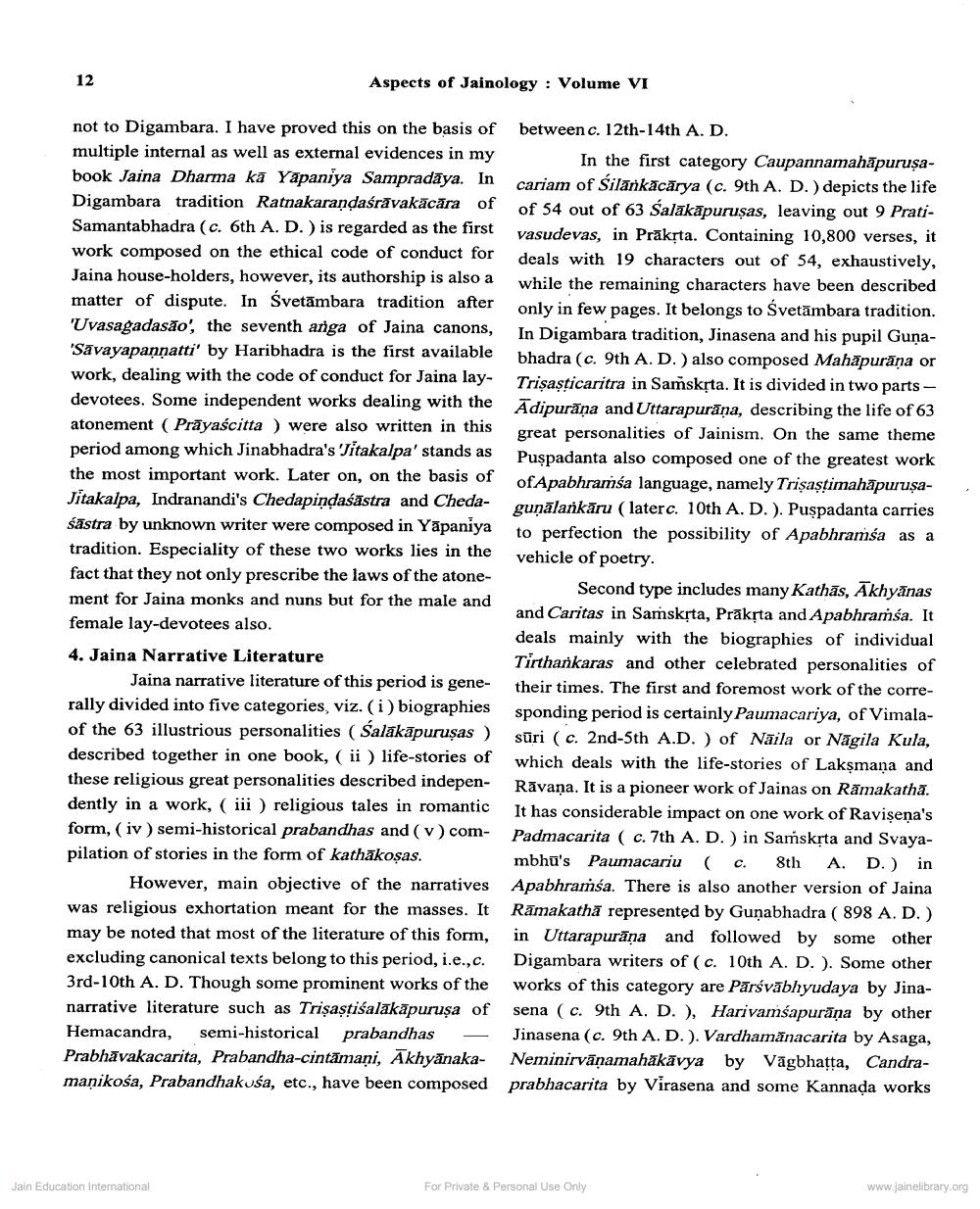________________
12
Aspects of Jainology : Volume VI
not to Digambara. I have proved this on the basis of between c. 12th-14th A. D. multiple internal as well as external evidences in my
In the first category Caupannamahāpurusabook Jaina Dharma ka Yapaniya Sampradāya. In cariam of silankācārya (c. 9th A. D. ) depicts the life Digambara tradition Ratnakarandaśrāvakācāra of of 54 out of 63 Salakapurusas, leaving out 9 PratiSamantabhadra (c. 6th A. D.) is regarded as the first
vasudevas, in Prūksta. Containing 10,800 verses, it work composed on the ethical code of conduct for
deals with 19 characters out of 54, exhaustively, Jaina house-holders, however, its authorship is also a while the remaining characters have been described matter of dispute. In Svetāmbara tradition after only in few pages. It belongs to Svetämbara tradition. 'Uvasagadasão', the seventh anga of Jaina canons, In Digambara tradition. Jinasena and his pupil Guna'Savayapannatti' by Haribhadra is the first available bhadra (c. 9th A. D.) also composed Mahapurāna or work, dealing with the code of conduct for Jaina lay
Trişaşticaritra in Samskrta. It is divided in two parts - devotees. Some independent works dealing with the Adipurina and Uttarapurana, describing the life of 63 atonement (Prāyaścitta ) were also written in this
great personalities of Jainism. On the same theme period among which Jinabhadra's Titakalpa' stands as Puspadanta also composed one of the greatest work the most important work. Later on, on the basis of of Apabhramsa language, namely TrişastimahāpurușaJitakalpa, Indranandi's Chedapindaśāstra and Cheda
gunālankāru (laterc. 10th A. D.). Puspadanta carries śāstra by unknown writer were composed in Yapaniya to perfection the possibility of Apabhramśa as a tradition. Especiality of these two works lies in the vehicle of poetry. fact that they not only prescribe the laws of the atone
Second type includes many Kathās, ākhyānas ment for Jaina monks and nuns but for the male and
and Caritas in Saṁskṛta, Prakrta and Apabhraṁsa. It female lay-devotees also.
deals mainly with the biographies of individual 4. Jaina Narrative Literature
Tirthankaras and other celebrated personalities of Jaina narrative literature of this period is gene- their times. The first and foremost work of the correrally divided into five categories, viz. (i) biographies sponding period is certainly Paumacariya, of Vimalaof the 63 illustrious personalities (Salakāpuruṣas ) sūri (c. 2nd-Sth A.D.) of Naila or Nagila Kula, described together in one book, (ii) life-stories of which deals with the life-stories of Laksmana and these religious great personalities described indepen- Ravana. It is a pioneer work of Jainas on Ramakathā. dently in a work, (iii) religious tales in romantic It has considerable impact on one work of Ravişena's form, (iv) semi-historical prabandhas and (v) com- Padmacarita (c. 7th A. D.) in Samskrta and Svayapilation of stories in the form of kathākoșas.
mbhu's Paumacariu ( c. 8th A. D.) in However, main objective of the narratives Apabhramsa. There is also another version of Jaina was religious exhortation meant for the masses. It Rāmakathā represented by Gunabhadra ( 898 A. D.) may be noted that most of the literature of this form, in Uttarapurāna and followed by some other excluding canonical texts belong to this period, i.e.,c. Digambara writers of (c. 10th A. D. ). Some other 3rd-10th A. D. Though some prominent works of the works of this category are Pārsvābhyudaya by Jinanarrative literature such as Trişastiśalākāpuruṣa of sena (c. 9th A. D.), Harivamsapurāņa by other Hemacandra, semi-historical prabandhas — Jinasena (c. 9th A.D.). Vardhamănacarita by Asaga, Prabhāvakacarita, Prabandha-cintămaņi, ākhyānaka- Neminirvānamahākāvya by Vāgbhatta, Candramaņikośa, Prabandhakuśa, etc., have been composed prabhacarita by Virasena and some Kannada works
Jain Education International
For Private & Personal Use Only
www.jainelibrary.org




